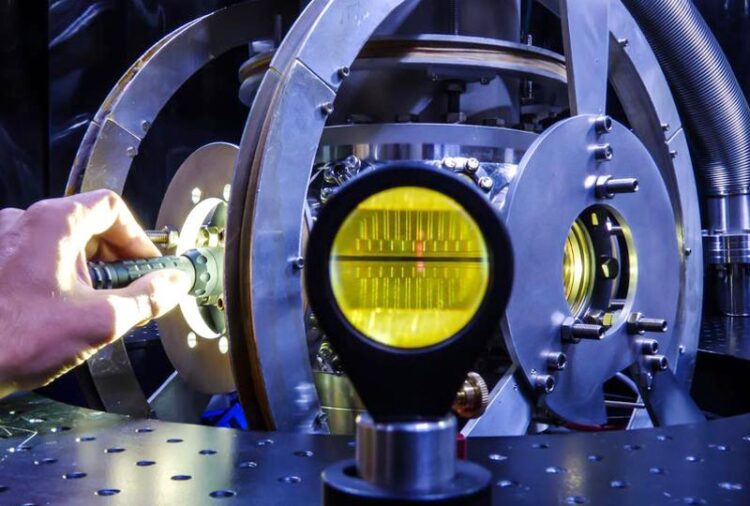Two qudits fully entangled

Trapped ions have several energy levels that can be used for computing.
Credit: Martin van Mourik / Universität Innsbruck
New way to entangle high-dimensional quantum systems.
Recently quantum computers started to work with more than just the zeros and ones we know from classical computers. Now a team at the University of Innsbruck, Austria, demonstrates a way to efficiently create entanglement of such high-dimensional systems to enable more powerful calculations.
In the world of computing, we typically think of information as being stored as ones and zeros – also known as binary encoding. However, in our daily life we use ten digits to represent all possible numbers. In binary the number 9 is written as 1001 for example, requiring three additional digits to represent the same thing.
The quantum computers of today grew out of this binary paradigm, but in fact the physical systems that encode their quantum bits (qubit) often have the potential to also encode quantum digits (qudits), as recently demonstrated by a team led by Martin Ringbauer at the Department of Experimental Physics at the University of Innsbruck. According to experimental physicist Pavel Hrmo at ETH Zurich: “The challenge for qudit-based quantum computers has been to efficiently create entanglement between the high-dimensional information carriers.”
In a study published in the journal Nature Communications the team at the University of Innsbruck now reports, how two qudits can be fully entangled with each other with unprecedented performance, paving the way for more efficient and powerful quantum computers.
Thinking like a quantum computer
The example of the number 9 shows that, while humans are able calculate 9 x 9 = 81 in one single step, a classical computer (or calculator) has to take 1001 x 1001 and perform many steps of binary multiplication behind the scenes before it is able to display 81 on the screen. Classically, we can afford to do this, but in the quantum world where computations are inherently sensitive to noise and external disturbances, we need to reduce the number of operations required to make the most of available quantum computers.
Crucial to any calculation on a quantum computer is quantum entanglement. Entanglement is one of the unique quantum features that underpin the potential for quantum to greatly outperform classical computers in certain tasks. Yet, exploiting this potential requires the generation of robust and accurate higher-dimensional entanglement.
The natural language of quantum systems
The researchers at the University of Innsbruck were now able to fully entangle two qudits, each encoded in up to 5 states of individual Calcium ions. This gives both theoretical and experimental physicists a new tool to move beyond binary information processing, which could lead to faster and more robust quantum computers.
Martin Ringbauer explains: “Quantum systems have many available states waiting to be used for quantum computing, rather than limiting them to work with qubits.” Many of today’s most challenging problems, in fields as diverse as chemistry, physics or optimisation, can benefit from this more natural language of quantum computing.
The research was financially supported by the Austrian Science Fund FWF, the Austrian Research Promotion Agency FFG, the European Research Council ERC, the European Union and the Federation of Austrian Industries Tyrol, among others.
Wissenschaftliche Ansprechpartner:
Martin Ringbauer
Institut für Experimentalphysik
Universität Innsbruck
+43 512 507 52458
martin.ringbauer@uibk.ac.at
https://www.quantumoptics.at
Originalpublikation:
Native qudit entanglement in a trapped ion quantum processor. Pavel Hrmo, Benjamin Wilhelm, Lukas Gerster, Martin W. van Mourik, Marcus Huber, Rainer Blatt, Philipp Schindler, Thomas Monz, Martin Ringbauer. Nature Communications 14, 2242 (2023) (Open Access) https://doi.org/10.1038/s41467-023-37375-2
Weitere Informationen:
http://www.uibk.ac.at/en/newsroom/2022/erc-starting-grant-for-quantum-physicist-… – ERC Starting Grant for quantum physicist Martin Ringbauer
Media Contact
All latest news from the category: Information Technology
Here you can find a summary of innovations in the fields of information and data processing and up-to-date developments on IT equipment and hardware.
This area covers topics such as IT services, IT architectures, IT management and telecommunications.
Newest articles

A blueprint for mapping melting ice sheets
Researchers in the Stanford Radio Glaciology lab use radio waves to understand rapidly changing ice sheets and their contributions to global sea-level rise. This technique has revealed groundwater beneath Greenland,…

Water hyacinth plant pots – utilization of an invasive species
Together with Fiber Engineering GmbH, the DITF presents a process for the production of biodegradable plant pots. The products are cost effective and competitive. At the same time, the production…

Current research on the new 6G mobile communications standard
Nursing care robots, autonomous driving, digital twins: all of these high-tech applications will play an essential role for the new 6G mobile communications standard. The first commercial 6G networks are…



